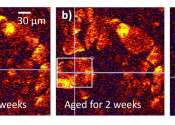Laser imaging could offer early detection for at-risk artwork
Look closely at Impressionist paintings in museums compared with photos of them taken 50 years ago, and you might notice something odd: Some are losing their bright yellow hues.

Look closely at Impressionist paintings in museums compared with photos of them taken 50 years ago, and you might notice something odd: Some are losing their bright yellow hues.
Optics & Photonics
Apr 29, 2024
0
36

Researchers from the Natural History in London have collaborated with researchers from the National Academy of Sciences of Ukraine to establish the cause of damage to the world-famous medieval murals in Kyiv's Saint Sophia ...
Archaeology
Sep 28, 2022
0
28

Climate change may be accelerating the degradation of ancient rock paintings in Indonesia, including the oldest known hand stencil in the world which dates back to 39,900 years ago, according to a study published in Scientific ...
Archaeology
May 13, 2021
1
85
In 2014, the art conservation world was thrown into chaos when the company producing MS2A varnish shut down. No one else had the technical knowledge to continue making the go-to varnish for art conservators worldwide.
Materials Science
Jul 30, 2020
0
5
The graceful ceramic pedestal was coated with a thin layer of dirt, some of it perhaps lodged in the artifact's clay pores for thousands of years.
Archaeology
Feb 27, 2018
0
11

Combining the mathematics of digital image processing with the history, craftsmanship and science of art conservation, the Bass Connections Image Processing Algorithms for Art Conservation team spent last year working with ...
Software
Nov 21, 2017
0
5

A good art dealer can really clean up in today's market, but not when some weird chemistry wreaks havoc on masterpieces.
Other
Apr 20, 2017
0
10

Micrometric and sub-micrometric contaminant particles—what most of us call "dust"—can cause big problems for art conservators, the electronics industry, aerospace engineers, and others. These nanoparticles can prevent ...
Materials Science
Apr 28, 2016
0
392

A Northwestern University research team has taken CSI to a whole new level: employing sophisticated scientific tools to investigate details of the materials and methods used by Roman-Egyptian artists to paint lifelike mummy ...
Analytical Chemistry
Feb 14, 2016
0
1006

French artist Paul Gauguin is well known for his colorful paintings of Tahitian life—such as the painting that sold recently for nearly $300 million—but he also was a highly experimental printmaker. Little is known, however, ...
Computer Sciences
Feb 14, 2015
0
688